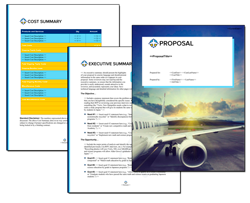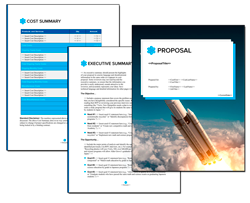
How to Write an Aerospace Proposal for Success
Wondering how to write an aerospace proposal that wins approval or funding? This guide will take you through each crucial step, from understanding industry demands to presenting innovative solutions effectively.
Key Takeaways
- Aerospace proposals must demonstrate a thorough understanding of the industry and technical components to secure funding and ensure project feasibility.
- An effective proposal includes a well-structured executive summary, clear project scope and objectives, detailed budget analysis, and a realistic timeline to foster stakeholder confidence.
- Using proposal writing tools like Proposal Kit and maintaining a visually appealing design are crucial for enhancing the professionalism and clarity of the submission, ultimately improving the chances of acceptance.
Understanding the Aerospace Industry

The aerospace industry is heavily influenced by significant federal spending, with the Department of Defense budget growing over the years. This substantial investment underscores the importance of precise and well-crafted proposals to secure funding and support. Major aerospace hubs such as Seattle and Los Angeles are hotbeds of advanced aerospace technologies, making them critical locations for industry activities and innovation.
The aerospace supply chain is extensive and complex, encompassing sectors like metals, composites, and electronics. This complexity necessitates a thorough understanding of various components and their integration into the final product. A successful proposal must demonstrate a clear grasp of these elements to reassure clients of the project's feasibility and potential for success.
Understanding the Proposal Process
Navigating the proposal process is a foundational step in creating a successful engineering service proposal within the aerospace industry. The process typically begins when a potential client issues a request for proposal (RFP), outlining their specific needs, project requirements, and evaluation criteria. Carefully reviewing the RFP is essential, as it sets the expectations and standards your proposal must meet to be considered.
A well-structured proposal should demonstrate a thorough understanding of the client's objectives and provide a detailed description of the proposed solution. Key components such as a personalized cover letter, a concise executive summary, and a clearly defined project scope are vital for capturing the client's interest and establishing credibility. Additionally, a transparent breakdown of costs and a realistic budget show your commitment to delivering value and managing resources effectively.
Throughout the proposal process, it's important to address each requirement outlined in the RFP, ensuring your written response aligns with the client's goals and evaluation criteria. By following this structured approach and including all necessary elements, your business can demonstrate its engineering expertise, increase the likelihood of securing funding, and stand out in a competitive field of projects.
Executive Summary

An executive summary is the cornerstone of any business proposal, providing a concise overview of the project's key elements. Clients value clarity and organization, which aids in the effective evaluation of complex information. A well-written executive summary should outline:
- the project scope
- objectives
- proposed solution
- budget
- timeline
This gives the potential client a snapshot of what to expect and answers the subject.
The cover letter, serving as the initial point of contact, is crucial for making a strong first impression on potential clients. Key elements to include are:
- A personalized offer that addresses the specific needs and pain points of the client.
- Reading the RFP thoroughly before drafting the cover letter ensures your proposal aligns with the client's themes and requirements.
- A strong closing statement that reiterates your capabilities, fostering a connection with the client.
Demonstrating your team's qualifications and past achievements is vital to building trust with funds. Detailed descriptions of your team's expertise and previous successful projects can significantly enhance the credibility of your proposal. Referencing similar projects you have completed is especially important, as it reassures the client of your familiarity with comparable challenges and demonstrates your relevant experience. Showcasing these elements effectively can help raise doubts and explain an executive summary that informs and persuades.
Project Scope and Objectives

Defining the project scope and objectives is a critical step in proposal writing. This section should clearly outline the work required to deliver the project's output on time and within budget. Effective budget planning requires aligning it with broader organizational goals to ensure resources are allocated strategically. Collaboration between engineers and product owners is essential to present a unified proposal to stakeholders.
A clear outline of individual roles and responsibilities within the team demonstrates accountability and ensures all team members understand each specific task assigned to them. Defining these tasks as distinct activities or assignments within the project helps clarify the project scope, supports effective planning, and strengthens the proposal by showing a thorough understanding of deliverables and responsibilities.
Setting clear, achievable goals provides a solid foundation for the proposal, simplifying stakeholder evaluation of feasibility and potential success.
Here are some related samples included in every downloadable Proposal Pack
The AI Writer generates a first draft of these templates - customized to your company, client, and project - in just minutes, giving you a head start on editing. Get any Proposal Pack or Proposal Kit Professional, and all of these samples, and the AI Writer are included.
Here are some related downloadable templates
The AI Writer generates a first draft of these templates - customized to your company, client, and project - in just minutes, giving you a head start on editing. Get any Proposal Pack or Proposal Kit Professional, and all of these templates and the AI Writer are included.
Creating a Compelling Business Proposal
Creating a compelling business proposal is both an art and a science, requiring a blend of technical know-how, persuasive writing, and meticulous attention to detail. Start your proposal with a strong introduction that immediately captures the reader's attention and clearly states the purpose of your submission. This sets the stage for the rest of your document and signals your professionalism to potential clients.
Next, provide a comprehensive description of the project, outlining its objectives, scope, and anticipated timeline. Clearly articulate your proposed solution, highlighting any innovative tools, technologies, or methodologies that set your approach apart from the competition. This is your opportunity to demonstrate your expertise and show how your business can deliver exceptional results.
A detailed breakdown of costs and a transparent budget are essential for building trust and showing that you have carefully planned every aspect of the project. Don't forget to address potential risks and challenges, explaining how your team will manage them to ensure project success. By presenting a well-organized, detailed, and visually appealing business proposal, you not only demonstrate your capability but also increase your chances of winning new projects and building lasting client relationships.
Proposed Solution
Innovation is the lifeblood of the aerospace industry, driving advancements in unmanned aerial systems and cleaner technologies like biofuels. When outlining your proposed solution, it's crucial to highlight the specific technologies and methodologies you plan to use. This not only demonstrates the feasibility and innovation of your solution but also helps stakeholders understand how you will achieve the desired outcomes. Clearly explain how you intend to implement these technologies and methodologies to ensure they deliver the expected results.
Clarifying the benefits of the proposed technologies can help stakeholders appreciate their value in addressing project challenges. Highlighting unique problem-solving strategies can differentiate your project from competitors. Including detailed descriptions of methodologies and listing key deliverables in the project scope can help describe tangible targets for completion.
To create a compelling proposal, consider the following strategies:
- Use examples of previous projects to showcase your organization's ability to deliver on proposals.
- Incorporate data visualizations like charts and infographics to make complex information more digestible and engaging for evaluators.
- Present a well-rounded and innovative solution to strengthen your case.
Budget and Cost Analysis

Budget considerations and cost evaluations are critical components of any aerospace proposal. Clients look for reasonable pricing alongside detailed financial analysis. Defining the project objectives, including what will be done, when, and the expected costs, is essential. Preparation for unexpected costs and changes necessitates the development of contingency plans during budget creation.
A project scope statement outlines the necessary work to deliver a project's output on time and within budget. Justifying headcount increases requires a comprehensive view of project needs and how new roles can provide essential support.
Clearly explaining your budget and cost analysis builds trust with stakeholders and demonstrates the financial feasibility of your project, especially when it comes to money.
Project Schedule and Timeline
A well-organized timeline is essential for preventing delays and ensuring that all necessary steps are completed in the correct order. Timelines facilitate better resource allocation and assist teams in tracking progress effectively. Visualizing each stage of the project through a timeline enhances collaboration and reduces confusion among stakeholders.
A detailed project proposal timeline can illustrate estimated durations and scheduling dates, ensuring realistic planning. Preparing the submission package ahead of the deadline can mitigate last-minute issues.
Providing a clear and realistic timeline helps stakeholders understand the project's trajectory and ensures timely delivery.
Team Expertise and Capabilities
The aerospace and defense industries are characterized by:
- High wages, with average earnings around low six figures per year, indicate the value placed on expertise.
- A workforce increasingly requiring digital skills alongside traditional manufacturing capabilities, highlighting the need for modern expertise.
- The prioritization of effective communication to enhance team productivity and ensure that budget plans are implemented smoothly.
- Visibility into resource allocation is pivotal for accurately estimating working costs and managing team dynamics effectively. Showcasing the team's expertise and capabilities is essential as it directly influences the credibility and attractiveness of your aerospace competition proposal.
- Combining expertise in the aerospace sector with effective communication creates a strong foundation for a successful proposal.
Risk Assessment and Management

Aerospace engineering projects face various risks categorized into project management, engineering, and industry-specific risks. Typical project management risks include poor planning, unrealistic milestones, and miscommunication among team members. Engineering risks can stem from changes in regulations, potential accidents during manufacturing, and issues with outsourced components.
Effective risk management in aerospace involves planning, identifying, analyzing, developing response strategies, and monitoring risks continuously. A comprehensive risk assessment in proposals can enhance credibility and directly influence evaluation outcomes.
Identifying constraints helps clarify limitations that the project team faces during execution. Addressing these risks proactively demonstrates a thorough understanding of the challenges and readiness to analyze them.
Proposal Writing Tools and Templates
Proposal Kit offers specialized templates and automation tools tailored for creating aerospace proposals, streamlining the writing process. The software provides an AI-driven content writer that generates draft proposals quickly, allowing users to focus on editing and preparing a technical proposal for an engineering service proposal.
Using project management tools can transform a proposal timeline into an actionable plan, helping teams track tasks and resources in real time. The Proposal Kit features sample proposals for airline and aerospace-related proposals, which can serve as valuable references for a deal.
Leveraging these tools and templates enhances the efficiency and quality of your proposal writing process, ensuring a polished and professional final product that you can write with confidence. Writing proposals can significantly improve your chances of success.
Visually Appealing Design
An appealing visual layout influences a client's perception of professionalism and engagement. Proposal Kit provides various design themes and premade layouts to enhance the visual appeal of proposals. Those who are interested in utilizing visuals, such as diagrams and charts, can simplify complex details and enhance understanding.
Consistency in formatting, including font styles and sizes, is crucial for clarity throughout the proposal. Incorporating accessibility features like alt text for images ensures proposals are inclusive and easily understood.
Using visuals in the cover letter can highlight key points without distracting from the main background message. Finalizing the proposal involves checking that it is visually appealing and easy to read.
 Proposal Kit Professional provides the most content, including legal contracts and a free design theme pack. Plus, advanced software features include custom branding and customizable quoting databases.
Proposal Kit Professional provides the most content, including legal contracts and a free design theme pack. Plus, advanced software features include custom branding and customizable quoting databases. Proposal Pack for Any Business covers this type of proposal and includes samples. There are also some commonly used specialty design themes available:
Proposal Pack for Any Business covers this type of proposal and includes samples. There are also some commonly used specialty design themes available:Photo Design Proposal Packs
Line Art Design Proposal Packs
 Proposal Pack Aerospace #1
Proposal Pack Aerospace #1 Proposal Pack Aerospace #2
Proposal Pack Aerospace #2 Proposal Pack Contemporary #3
Proposal Pack Contemporary #3 Proposal Pack Contemporary #6
Proposal Pack Contemporary #6 Proposal Pack Global #1
Proposal Pack Global #1 Proposal Pack Global #2
Proposal Pack Global #2 Proposal Pack Global #3
Proposal Pack Global #3 Proposal Pack In Motion #1
Proposal Pack In Motion #1 Proposal Pack In Motion #2
Proposal Pack In Motion #2 Proposal Pack In Motion #4
Proposal Pack In Motion #4 Proposal Pack In Motion #5
Proposal Pack In Motion #5 Proposal Pack Military #3
Proposal Pack Military #3
Evaluation Criteria
Funders often evaluate the experience of key personnel to determine the viability of a project proposal. Clients in the aerospace sector frequently assess proposals based on the technical capabilities and performance history of the bidders. Past performance is a significant factor in evaluation, focusing on the relevance and success of previous projects similar to the proposed work.
Compliance with the client's requirements should be verified against the original RFP to ensure all elements are included. By understanding and meeting these evaluation criteria, you can increase the chances of your proposal being accepted and funded.
Cover Letter
A well-written cover letter serves as an introduction to your proposal, emphasizing your genuine interest in the project and your dedication to meeting the client's needs. The cover letter is a critical component that can set the tone and align your message with the expectations of the client. It should include a brief overview of your company, an introduction to the services you provide, and a summary of what you hope to achieve with the proposal.
Convey enthusiasm by personalizing your cover letter with references to the client's specific needs and demonstrating how your solution aligns with their vision. You can further reinforce your reliability and value by mentioning your high customer satisfaction or strong renewal rates, showing that your customers consistently trust and benefit from your services. Writing a compelling cover letter creates a positive first impression and sets the stage for a successful proposal.
Final Review and Submission
A thorough self-review of the proposal is essential to ensure clarity and coherence before submission. To enhance the proposal's quality and effectiveness, consider the following steps:
- Obtain feedback from team members or external reviewers.
- Proofread the executive summary to avoid errors.
- Ensure the executive summary accurately reflects the project's aims.
Proofreading for spelling and grammar errors is vital for presenting a professional proposal. Ultimately, all of these steps are necessary to ensure the proposal is thorough, clear, and professional before submission.
Following this final step review process allows you to confidently submit a polished and complete proposal.
Summary

Writing a successful aerospace proposal requires a strategic approach, from understanding industry dynamics to finalizing your submission. Key elements include a clear executive summary, defined project scope and objectives, innovative proposed solutions, and thorough budget and cost analysis. Additionally, a well-organized timeline, showcasing team expertise, effective risk management, and the use of proposal writing tools are critical.
By following these guidelines, you can create compelling proposals that stand out and secure funding. Embrace the challenge and apply these strategies to master the art of aerospace proposal writing. Your next successful project awaits.
Frequently Asked Questions
What is the format for writing a proposal?
The format for writing a proposal should typically include a cover/title page, abstract, table of contents, introduction or statement of need, description of proposed research, biographical sketch, current and pending support, facilities and equipment, and budget. Adhering to this structure ensures clarity and comprehensiveness in your presentation.
Why is an executive summary important in a business proposal?
An executive summary is crucial in a business proposal as it offers a concise overview of the project's key elements, enabling clients to quickly grasp the proposal's value and feasibility. Its clarity and focus can significantly influence decision-making.
How can I ensure my proposed solution stands out?
To ensure your proposed solution stands out, emphasize its innovative aspects and the specific technologies being utilized, while also providing detailed problem-solving strategies and examples from previous successful projects. This approach not only showcases your expertise but also demonstrates the practical application of your solution.
What should be included in a risk assessment?
A comprehensive risk assessment should include identification of potential risks related to project management, engineering, and industry-specific factors, as well as strategies for response and plans for ongoing monitoring. This ensures effective management of risks throughout the project lifecycle.
How can Proposal Kit help with writing proposals?
Proposal Kit simplifies the proposal writing process by providing specialized templates, design themes, and an AI-driven content writer. This ensures your proposals are professional and tailored to meet your specific needs.



 Cart
Cart
 Are you just looking for a template, sample, or software for your aerospace industry proposals? Click these links to skip down the page and get right to it.
Are you just looking for a template, sample, or software for your aerospace industry proposals? Click these links to skip down the page and get right to it.





 Facebook
Facebook YouTube
YouTube Bluesky
Bluesky Search Site
Search Site